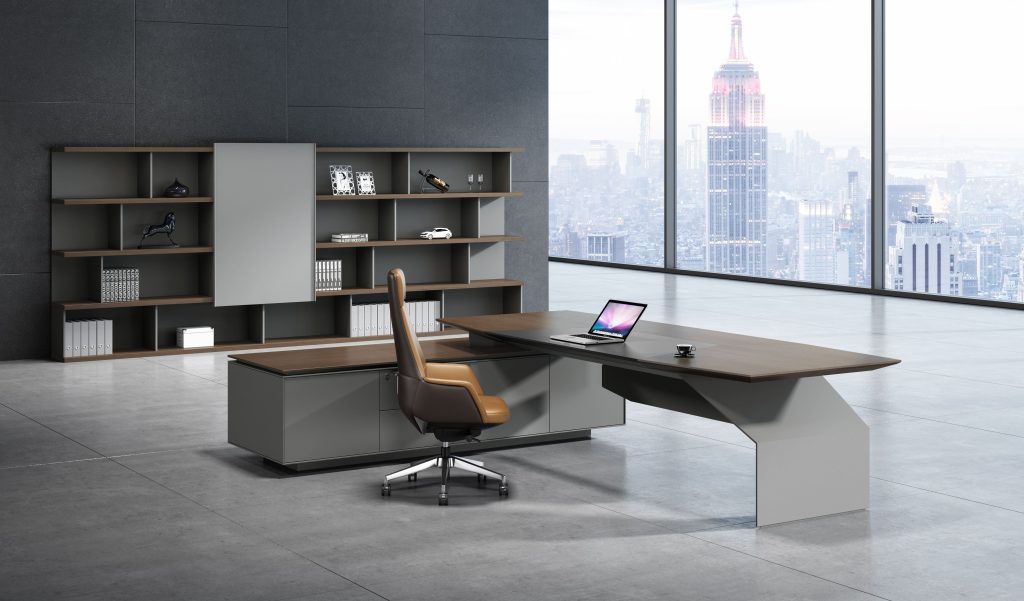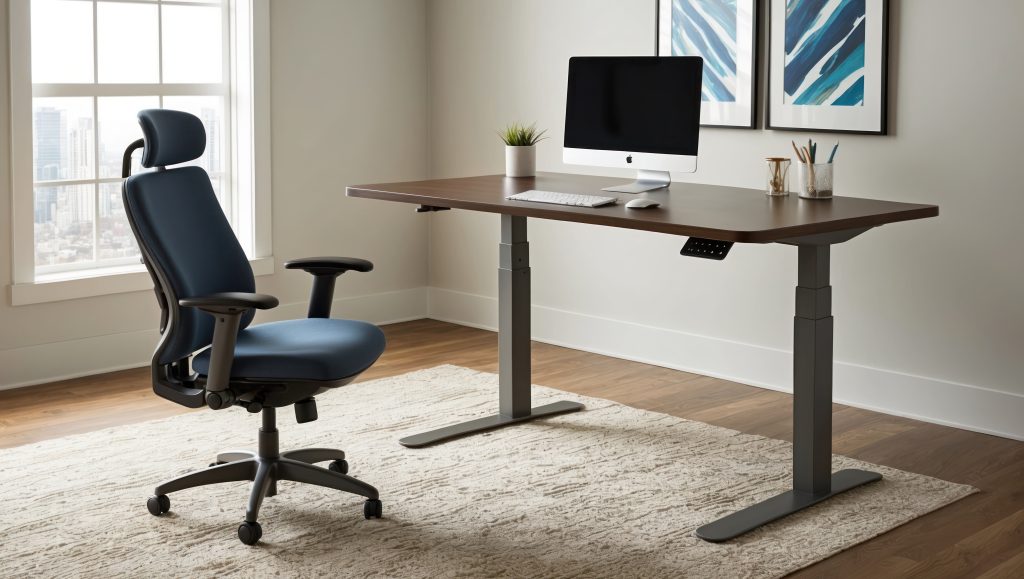
Choosing the right desk size determines not only how comfortably you work, but also how your equipment fits, how your posture develops, and how your room layout performs over time. Desk dimensions influence everything—from monitor distance and keyboard positioning to cable routing, chair movement, and storage.
This 2025 guide explains the most common desk sizes used today and adds expert-level depth on thickness, load capacity, cable management, monitor arm compatibility, and room-fit calculations—helping you make a confident decision whether you're planning a home workstation or an entire office floor.
Before choosing desk dimensions, it helps to understand how people physically interact with the work surface. Every desk, regardless of size, can be divided into three functional zones:
This is where the keyboard, mouse, and wrist support must live. A shallow 20–22 inch desk barely covers this area, often forcing monitors too close.
This zone stores notebooks, coffee, phones, and daily-use tools. Standard 24–27 inch desk depths comfortably include this area.
This zone holds monitors, desk lamps, or décor. For dual or ultra-wide screens, a minimum depth of 28–30 inches prevents neck strain.
Why this matters:
Shallow desks collapse the secondary and tertiary zones, compressing equipment and forcing poor posture. Understanding zones helps you choose the right depth.
Most desks sit between 28–30 inches (71–76 cm). This height suits most adults when paired with an adjustable ergonomic chair. Standing desks offer a much broader range—22–48 inches (56–122 cm)—to support movement throughout the day.
Each desk category has standard dimensions, but the real question is how its size supports your workflow and equipment.
Standard desks usually range from 47–60 inches wide and 23–30 inches deep. They suit one or two monitors and fit most corporate layouts without overwhelming the room.
These dimensions hit the sweet spot between comfort and space efficiency, especially in open-plan benching systems.
Executive desks expand to 60–72 inches in width and 30–36 inches in depth, accommodating paperwork, multi-device workflows, and occasional guest seating.
They are ideal when surface area contributes to productivity and presence.

Standing desks typically measure 48–72 inches wide and 24–30 inches deep. Since they carry motors and may support heavy monitor arms, proper load capacity (≥ 150 lbs) matters more than in fixed desks.
L-shaped configurations range from 55–72 inches on the main side and 47–60 inches on the return. They create two usable work zones—one for screens and one for tasks such as writing, reviewing documents, or meetings.
These desks provide an immersive workspace with three connected surfaces. Widths typically fall between 60–72 inches, with wing sections between 48–60 inches each. They are common in executive and administrative offices.
Compact desks range from 31–43 inches wide and 18–23 inches deep. They fit phone booths, small rooms, and bedrooms while still supporting a laptop model or compact monitor.
Computer desks increase depth to support triple-monitor curvature and stable arm mounting.
Recommended minimum widths:
Recommended minimum depths:
Modern offices often prefer shared stations. Each person typically needs 47–60 inches of width and 23–30 inches of depth. That results in total widths between 94–120 inches.
Bench desks must also allow cable trays under the center divider.
| Desk Type | Typical Width | Depth | Best For | Minimum Room Size Needed |
|---|---|---|---|---|
| Standard Desk | 47"–60" | 23"–30" | General work | 6 ft × 6 ft |
| Executive Desk | 60"–72" | 30"–36" | Managers | 8 ft × 8 ft |
| Standing Desk | 48"–72" | 24"–30" | Sit–stand work | 6 ft × 6 ft |
| L-Shaped Desk | 55"–72" + 47"–60" | 24"–30" | Dual workflows | 8 ft × 8 ft |
| U-Shaped Desk | 60"–72" + wings | 24"–30" | Heavy multitasking | 10 ft × 10 ft |
| Compact Desk | 31"–43" | 18"–23" | Small rooms | 5 ft × 5 ft |
| Computer Desk | 47"–63" | 25"–31" | Multi-monitor setups | 6 ft × 6 ft |
| Two-Person Desk | 94"–120" | 23"–30" | Shared teams | 10 ft × 6 ft |
Most monitor arm clamps require a desk thickness of 0.4–2.4 inches (1–6 cm).
If the desk is too thin, it may bend under pressure; if too thick, the clamp cannot attach.
Recommended thickness:
Standing desks should support at least 150–220 lbs to accommodate dual monitors, speakers, and office tools.
Executive desks may support more depending on construction.
If your desk is against a wall, you should reserve 2–3 inches behind the desk for cables or mount monitors using arms.
You may also need:
These impact overall desk depth and minimum clearance.
Desk requirements depend on how you work and the room you're designing.
Most home workspaces benefit from desks 47–60 inches wide, offering enough space for screens and personal items while fitting smaller rooms.
Businesses often standardize desks between 55–60 inches. This ensures consistent ergonomics and predictable aisle spacing.
Designers, architects, and engineers usually need 60–72 inch desks with depths of 30 inches or more for wide monitors and drawing tablets.
Compact desks 31–43 inches wide are best when space is limited.

Choosing a desk is a workflow decision, not a furniture decision.
First, evaluate your equipment. Multi-monitor setups require more depth and width, while laptop-only workflows can use narrower surfaces. Next, measure the available room, ensuring enough clearance behind the chair—typically 36–48 inches.
Then consider ergonomics: your elbows should rest naturally at 90 degrees, your monitor should be at eye level, and viewing distance should be 20–30 inches. Finally, plan for cable routing and future upgrades such as monitor arms or sit–stand conversion kits.
Many desks fail because users underestimate depth. A desk may look wide enough but still force monitors too close if it lacks 28–30 inches of depth. Another mistake is ignoring thickness: buying a desk incompatible with monitor arms is a common frustration.
Some users forget chair clearance or room circulation, leading to cramped aisles. Others overlook cable routing, placing the desk flush against the wall without grommet openings. Each of these mistakes can dramatically impact long-term comfort.
Example:
27" monitor → 27 × 0.55 = 14.8 inches viewing radius
Add keyboard zone → 28–30" desk depth recommended
Is a 40-inch desk too small?
Yes, a 40-inch desk is generally too small for dual monitors. It is acceptable for a laptop-only setup but lacks depth and width for ergonomic viewing or accessories.
Is a 55-inch desk good for two monitors?
Yes, 55 inches is the minimum recommended width for dual 24-inch monitors.
For two 27-inch monitors, choose 60–72 inches for better spacing.
Is 60 inches enough for a gaming or computer desk?
Yes, 60 inches supports dual 27-inch screens or one 49-inch ultrawide. For triple setups, choose ≥ 72 inches.
What size desk is best for small rooms?
Rooms under 6×6 ft work best with desks 31–43 inches wide and 18–23 inches deep.
How deep should a desk be?
Most users need 24–30 inches. Dual and triple monitors require 28–31 inches for proper viewing distance.
Desk size plays a critical role in ergonomics, productivity, and long-term workspace adaptability. By understanding standard dimensions, monitor requirements, room clearance, and technical details such as thickness and cable routing, you can design a workstation optimized for both comfort and efficiency.
Whether you’re furnishing a home office, upgrading a multi-monitor workstation, or planning an entire corporate layout, the right desk dimensions help create a workspace that performs flawlessly for years.
